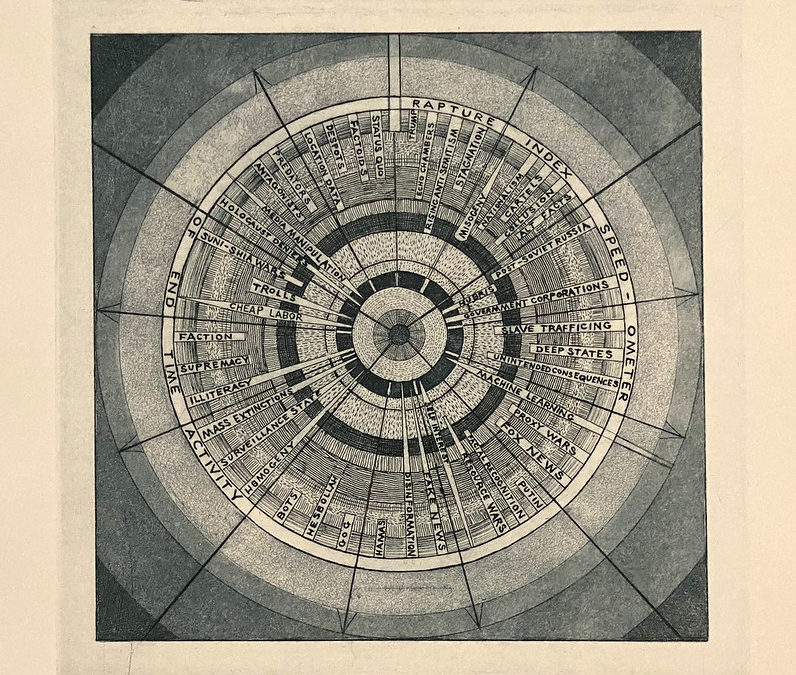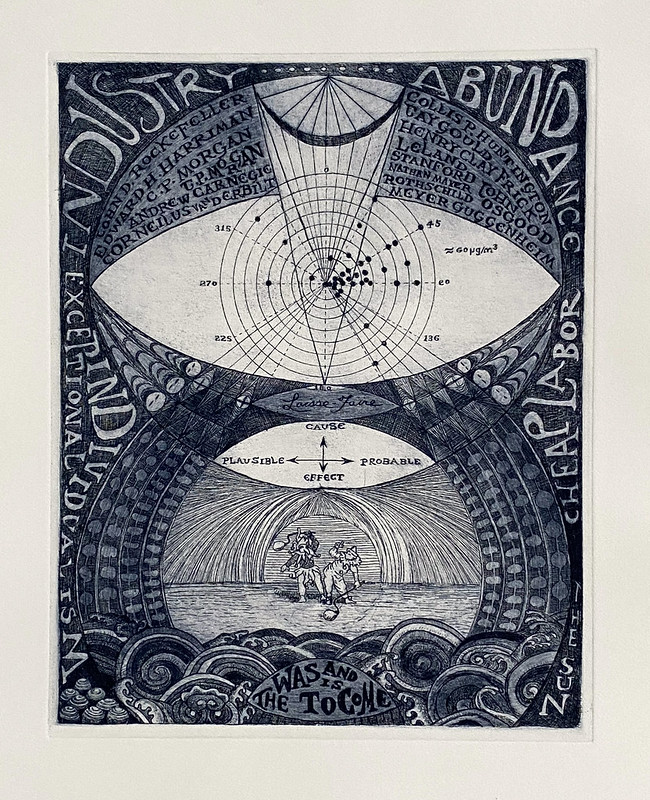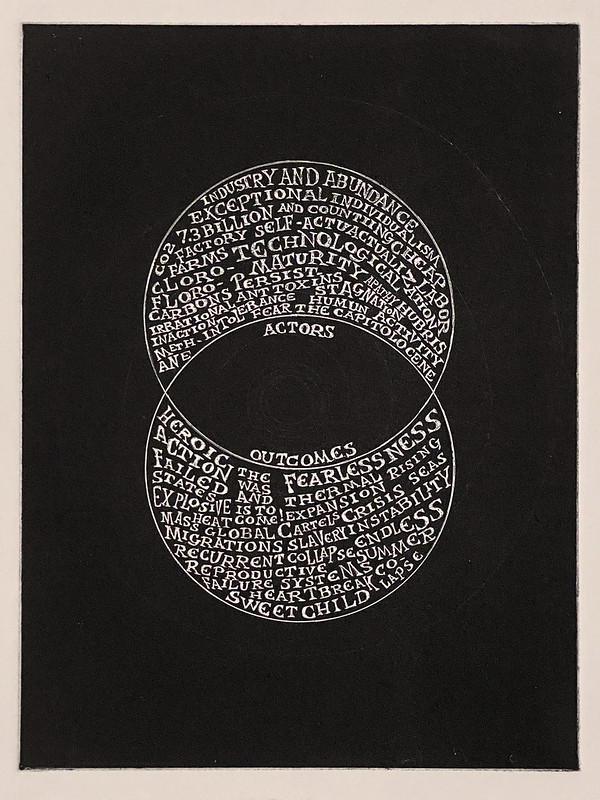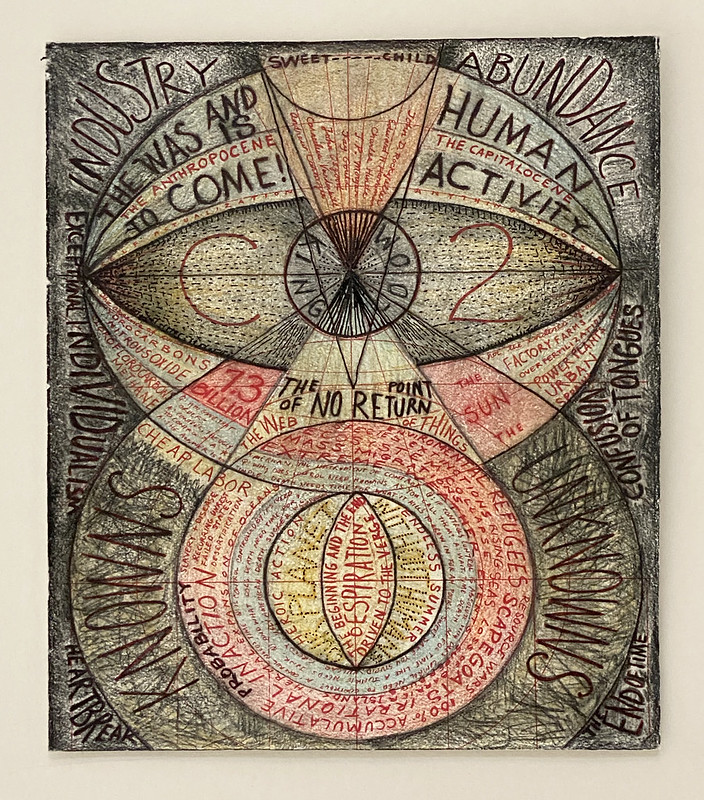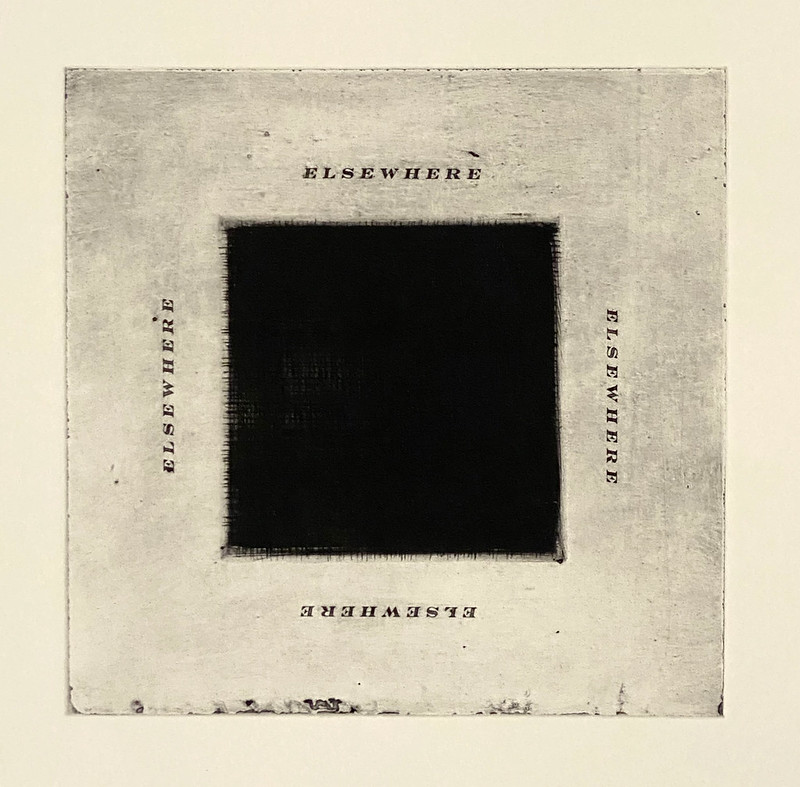Date/Time
Date(s) - 09/25/2020 - 11/03/2020
10:00 am until 5:00 pm
Location
Buffalo Arts Studio
Categories
Ominous Work
Curatorial essay by Shirley Verrico In the exhibition Industry and Abundance, Henderson seeks to visualize an etiology of global heating. Henderson’s charting of the carbon economy, what Amitav Ghosh refers to as “the great derangement,” begins with 19th century steam-powered gunboat diplomacy, then tracks the rapid expansion of global free trade, and ends with a view of the speculative future. Henderson points to contributing factors including the rapid growth of private ownership, sanctification of wealth accumulation, and the exploitation of the earth’s abundance. The future and past are compressed into the present, where human and environmental repercussions of cheap labor and status quo is made palpable. Henderson’s work documents individual perceptions while also serving as an informal anthropological recording of anxiety and concern. Many of her compositions organize information using symbols from early scientific processes as well as alchemy, metaphysics, and taxonomy. Henderson adds historical gravity to the subject by using primarily etching and intaglio printing methods, both developed in the 15th century. Upon closer view, the work is clearly contemporary. The prints are relatively small in scale, suggesting they should be read like a page from a book. Henderson uses a variety of text styles to draw the viewer into her treatises. In some cases, like My Wishes for Donald and Top 65 US Landfall she meticulously draws each letter in Times New Roman, emphasizing the concentration that went into forming each letter as well as assembling her lists. In other work, like Irrational Inaction and The Legacy of Capitalism, Henderson uses her delicate script to construct a meditative labyrinth in which one hides from the obvious reality. Probability 100%, a claustrophobic collection of words, is the most dire and direct statement on the climate crisis. Henderson layers the text almost compulsively within the intersecting circles, using color to convey urgency. Perhaps the most ominous work in the exhibit is 38.8977 N x 77.0365 W, the coordinates for the White House in Washington DC. For Henderson, this point on the map is so black that we see only our reflection above the works “NOT OBSERVABLE, UNKNOWN TO THOSE EXPOSED, EFFECTS DELAYED, NEW RISK.” Her hand is present in every print and the labor of her process is evident in the impressions left by the plates and the press. Together, these artworks serve as a visual and visceral indexing of fears about both the present and the future. Part of Activism in the Arts and funded, in part, by the National Endowment for the Arts.
Artist Statement
The first step in liquidating a people is to erase its memory. Destroy its books, its culture, its history. Then have somebody write new books, manufacture a new culture, invent a new history. Before long that nation will begin to forget what it is and what it was… The struggle of man against power is the struggle of memory against forgetting. Milan Kundera One day in 2009 when I was drawing in my studio, listening to NPR, a cognitive psychologist was talking about how and why people often fear the wrong things. For example, most people have a palpable fear of flying yet they don’t think twice about walking down the street, let alone descending a flight of stairs. At the time I was thinking a lot about this topic and studying the visualization of information, so when one of the speakers described an x-y axis used by cognitive psychologists to chart and rate risks I immediately started mapping out various ways to map these complex ideas, reflecting upon and examining my own perceptions. The resulting body of work, titled Perception of Risk playfully mapped and visualized perceived risks to myself and others. The work in Industry and Abundance is both related to but distinct from Perception of Risk. The work is about climate change, factors contributing to it and its consequences, both historical and plausible. The work includes prints and drawings on both primed panel and paper surfaces using drawing tools, gouache, watercolor, and collage. Compositionally it borrows from some of the organizational structures used in the risk series but is more reliant on an intuitive approach. Formally, the work varies from textual/conceptual mapping to a more intuitive and pictorial approach where image and/or landscape holds primary meaning in the work.
Biography
Adele Henderson received her BFA in printmaking/painting from the University of Nebraska – Lincoln and MFA from Arizona State University. She joined the UB art department in 1987. Major awards include a National Endowment for the Arts Fellowship (Works on Paper), Constance Saltonstall Foundations for the Arts Fellowship, and residency fellowships at MacDowell, Yaddo, and Open Studio. Henderson’s artwork has been exhibited in over 170 solo and group exhibitions across the US and internationally including Australia, Finland, Japan, New Zealand, and Slovenia. Her prints and works on paper are in the collections of the Boston Museum Of Fine Arts; Fogg Art Museum, Harvard University; Albright-Knox Art Gallery; Nelson-Atkins Museum of Art; National Museum Of American Art; New York Public Library; and the Sheldon Memorial Art Gallery, among others. Learn more at: www.adelehenderson.com
Part of Activism in the Arts and funded, in part, by the National Endowment for the Arts.

